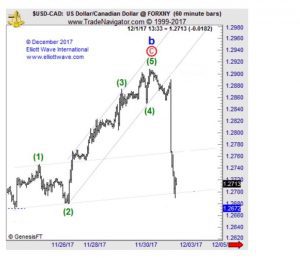以下、英語ですが、エリオット波動がUSDCADで機能した例を掲載します。USDCAD displayed a SELLOFF according to Elliott wave, which was called before a job report was announced.
エリオット波動分析 – 5波からABCの調整波のあと
Elliott Wave Analysis on USDCAD
(注:この記事は2017年12月10日に投稿していたものです)
エリオット波動がUSDCADで機能した例
英語でわかりづらいかもしれませんが、最初のチャートを見ていただくと、0.9という数値が見えます。これは、エリオット波動のガイドライン、「B波のリトレースメントレベルは、A波に対する90%」を根拠としています。ハーモニックパターンを使っていると、MT4ではフィボナッチ数値の88.6を使うバットパターンが検出される可能性があるということですね。
エリオット波動は、波をカウントするだけではなく、その波が作る山谷は、フィボナッチのレベルとの関係が深く、それゆえ、ハーモニックパターンとも切り離せないということになります。
記事の要点は、カナダの雇用統計発表前に、すでにUSDCADが下げるというシナリオをエリオット波動から描けていたということです。USDCADは、今でも検出されている日足の5-0パターンのPRZ(潜在的反転ゾーン)を背景に落ちています。当時に戻ると、USDCADのトレードは、経済指標の発表でドキドキしなくても、検出ツールが表示す5-0パターンとエリオット波動を組み合わせていれば、最強のショートができていたことになります。
ハーモニックパターンを使ったトレードに慣れてくると、押し目や戻り高値のない勢いの良いトレンド相場よりも、調整波となるABCのようにジグザグとした価格の動きのある時にパターンが良く出現するのが見えてきます。
The Loonie Takes Flight — BUT a “Labor Miracle” is NOT the Reason Why
(題:CADが買われた理由は労働市場の指標がミラクルに近い数値だったからというわけではない)
One day before the jobs numbers went viral, Elliott wave analysis already called for a USDCAD decline
By Elliott Wave International
Friday December 1 was a lucky break for loonie bulls. That day, the government agency Statistics Canada revealed the nation’s economy added 79,500 new jobs in November, “blowing past” the 10,000 that economists expected. As one major news source described it:
“Canadian dollar posted its biggest gain in nearly three months against its U.S. counterpart on Friday after a stronger-than-expected domestic jobs data fueled expectations for further Bank of Canada interest rate hikes early next year…”
“The labor miracle in Canada continues.” (Dec. 1 Reuters)
Absolutely, a jobs number that’s EIGHT times bigger than expected is a significant event for economists; some would even call it “miraculous.” But here’s the part we have trouble with: The spike was NOT the cause for the Canadian dollar’s surge. The reason we know that is because Elliott wave analysis foresaw a loonie rally before the jobs “miracle” was released. On November 30, a day before the surprise numbers went viral and stirred up a media frenzy, our Currency Pro Service editor Jim Martens set the stage for a decline in the USDCAD: (a falling U.S. dollar/rising Canadian dollar) Here is Jim’s analysis from his November 30 Currency Pro Service intraday update:
November 30 2:30 PM:
“USDCAD pushed to a new high on the day. Despite the new high the rally from 1.2672 might still represent wave b of a larger flat correction. A double top with 1.2915 would best serve the flat scenario. It would lead to a wave c decline that reaches below 1.2666. — Jim”
Jim also referenced the upcoming jobs data report: “Unemployment Claims is the next high impact economic release due out in the U.S. at 8:30 AM ET [Friday morning].”
Obviously, Jim had no way of knowing that the jobs claims would outperform expectations eight-fold. His analysis wasn’t based on the “fundamental” data, but rather on the Elliott wave pattern unfolding on the USDCAD’s price chart.
The next chart shows you how the currency pair followed its Elliott wave script to a T, with the greenback plunging and the loonie rising.
What makes forecasts like these possible is the fact that Elliott wave analysis tracks and forecasts market psychology. It’s the collective psychology of market players that create trends.
The loonie was poised to strengthen against the dollar regardless of what the labor report had said; there didn’t have to be any CAD-bullish news, period.

